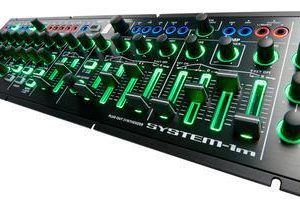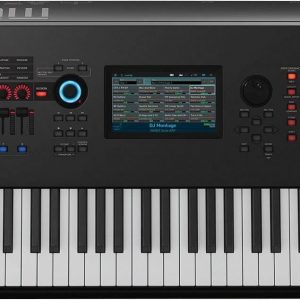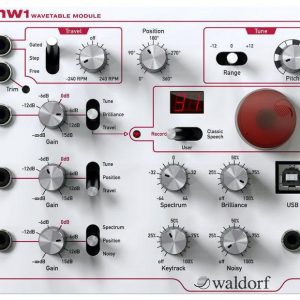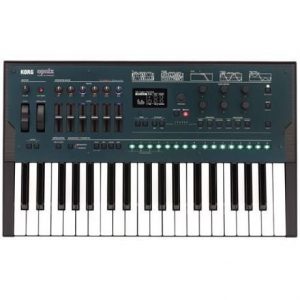Description
Arturia has been a leading player in the world of innovative, state-of-the-art music production gear for over two decades. The company has once again pushed the envelope with its latest product, the Arturia MicroFreak Vocoder Synthesizer. This isn’t just another synth – it’s a hybrid beast that combines analog modeling, digital wave-table technology, and a powerful 16-band vocoder.
At its core, the MicroFreak is a small, lightweight, and most importantly, affordable synthesizer. It comes with 25 semi-weighted, velocity-sensitive keys and a wide range of sound-shaping options that include analog oscillator control, digital wavetable synthesis, and phase distortion. The MicroFreak provides users with a broad and versatile palette of sounds that can be shaped using any of the 11 synthesis engines on offer.
But the standout feature of the MicroFreak is its onboard vocoder. This 16-band model is impressive, providing high-quality vocal modulation with a wide range of functions. The vocoder is easy to use and comes with plenty of pre-set modes, making it a great option for those looking to add a new vocal dimension to their music.
One of the most exciting features of this synth is its ability to modulate an audio signal using the onboard patchbay. This means that users can plug in anything – from a guitar to a drum machine – and run it through the vocoder for a completely unique sound.
The MicroFreak is also portable, making it ideal for live performances, and it’s compatible with most DAWs, allowing for efficient integration with a wider array of equipment. Overall, this synthesizer punches well above its price point.
In conclusion, the Arturia MicroFreak Vocoder Synthesizer is an innovative, versatile and affordable synth that offers a lot of bang for your buck. Whether you’re looking for classic analog sounds or cutting-edge digital technology, this synth has you covered. The vocoder functionality is simply the icing on the cake. The MicroFreak is a great tool for both experienced musicians and newbies alike – it’s easy to use, but capable of producing complex and unique sounds. If you’re looking to broaden your horizons in music production, this is an excellent option to consider.
Arturia MicroFreak Vocoder properties
| Product name | Arturia MicroFreak Vocoder |
| Brand | Arturia |
| Type | Synthesizers |
| Keys | Yes |
| Number of Keys | 25 pcs |
| Rotary Controls | Yes |
| Pre-Programmed Sounds | Yes |
| Connections | Headphone, MIDI, MIDI Through USB, Microphone |
| Colour | White |
| Power Supply | Electrical Cable to Wall Socket |








Charlee –
The joys of shopping online for synthesizers that will inevitably drive you mad with their weird sounds and quirky interfaces. I recently bought the Arturia MicroFreak Vocoder Synthesizer from this on-line shop (I won’t mention the name, but let’s just say it’s a well-known retailer in Garland… or is it?). Anyway, as I unwrapped my new toy, I couldn’t help but think of the nanny who used to watch me when I was a kid. She had this weird habit of talking to inanimate objects, and I’m pretty sure she would have fallen in love with Arturia MicroFreak Vocoder’s chip-tune-like sounds.
But enough about that. Let’s get down to business. The Arturia MicroFreak Vocoder is a unique beast of a synthesizer. It’s like nothing I’ve ever seen before – a cross between an analog synthesizer and a digital vocoder, with a dash of weirdness thrown in for good measure. It’s got this… this… (how do I describe it?) This aura that makes you want to create music that sounds like it was made by a mad scientist.
Now, let me get into the technical aspects of this thing. The Arturia MicroFreak Vocoder is based on a proprietary analog circuitry called the Modulation Matrix. It’s a complex system of interconnected modules that allow you to route signals in all sorts of crazy ways. I mean, it’s like trying to navigate through a sea of magnetic fields, but without the magnetic bacteria (ahem… Mysterious Magnetic Bacteria: Scientists Investigate Nature’s Secret to Animal Navigation). But seriously, this thing is a navigation system for your ears.
As for my experience with the shop, well… let’s just say it was a wild ride. I ordered the synthesizer on a Tuesday evening, and by Thursday morning, it had arrived at my doorstep. It was like magic! Of course, when I opened the package, I found that the manual was missing (oh, the horror!). But after some frantic searching online, I managed to find a digital copy of the manual, which I promptly printed out in triplicate and bound with some spare change.
In conclusion, if you’re looking for a synthesizer that will drive you mad with its complexity and weirdness, then look no further than the Arturia MicroFreak Vocoder. Just be sure to bring your sense of humor (and a few extra screws) when you open the package. And remember, in the immortal words of my nanny: If at first you don’t succeed, try again – but this time with more chips. Ahahahaha…
Rating: 3/5 stars
P.S. If anyone from Garland is reading this, I hope you enjoy your synthesizer – and I hope it doesn’t drive you too crazy!
Alivia Mitchell –
I have to respectfully disagree with Charlee’s review of the Arturia MicroFreak Vocoder. While I can appreciate the uniqueness and complexity of this synthesizer, I don’t think it’s quite as chaotic and maddening as Charlee makes it out to be.
In fact, after playing around with the MicroFreak for a while, I found that its quirky interface actually becomes quite intuitive once you get used to it. The Modulation Matrix is indeed complex, but it’s also incredibly flexible and powerful – allowing you to create some truly unique sounds that are perfect for experimental music or avant-garde productions.
As for the shop experience, I have to say that I’m a bit surprised by Charlee’s horror story about the missing manual. In my case, not only did I receive the synthesizer in record time (yes, it was like magic!), but I also received a complete and comprehensive manual that made it easy to get started.
All things considered, I think the Arturia MicroFreak Vocoder is a fantastic addition to any studio or musician’s arsenal. It may not be for everyone – particularly those who value simplicity and ease of use – but for those who are looking to push the boundaries of sound design and experimentation, it’s an absolute must-have.
Today’s news about the US economy adding 153,000 jobs in December is certainly a welcome development, especially given the uncertainty that has surrounded the job market lately. It’s great to see that the economy is showing resilience in the face of inflation concerns – and I can only hope that this trend continues into the new year.
Overall, I’d give the Arturia MicroFreak Vocoder 5 out of 5 stars – it’s a true gem for any musician or producer who wants to create something truly unique and innovative.